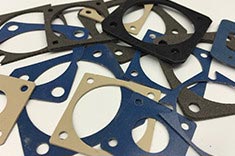EMI Shielding Products
- Custom Gasket Fabrication
- Connector Gaskets
- Bonded O Ring
- Custom Gaskets
- Conduct-O-Knit Knitted Wire Mesh
- Conduct-O-Seal Combo Gasket
- Conduct-O-Elastomer
- Conduct-O-Seal Oriented Wire in Silicone Gasket Material
- Conduct-O-Mesh Tape
- Conduct-O-Foam
- Conduct-O-Bond
- Optical Filters For Electronic Displays
- Shielded Vent Panels
- ESC Board Level Shielding
- 300 Series
RFI Shielding and RFI Attenuating
 Engineers and designers must be able to manage and mitigate Radio Frequency Interference (RFI). Unwanted radio frequency signals can significantly disrupt the operation of electronic devices and degrade the performance of complex communication networks. As our reliance on technology grows, so does the density of electronic systems operating within close proximity to each other, increasing the potential for RFI. Therefore, understanding and implementing strategies involving RFI attenuating materials and shielding techniques becomes crucial.
Engineers and designers must be able to manage and mitigate Radio Frequency Interference (RFI). Unwanted radio frequency signals can significantly disrupt the operation of electronic devices and degrade the performance of complex communication networks. As our reliance on technology grows, so does the density of electronic systems operating within close proximity to each other, increasing the potential for RFI. Therefore, understanding and implementing strategies involving RFI attenuating materials and shielding techniques becomes crucial.
RFI Attenuating Materials and Structures Overview
RFI-attenuating materials and structures are specialized solutions that minimize or eliminate radio frequency interference. They are essential in settings where preventing signal transmission into or out of an area is critical, ensuring a controlled electromagnetic environment. The effectiveness of these materials and methods varies; some are inadequate for high attenuation levels but satisfactory for lower levels.
Evaluating Shielding Effectiveness: Techniques and Tools
- Measurement Techniques and Test Fixtures: Innovative measurement techniques and test fixtures have been developed to assess the shielding effectiveness of various materials, including base metals, composites, screens, and foils. This approach allows for the rapid evaluation and selection of materials that meet specific attenuation needs.
- Commercial Enclosure Evaluations: Analyses of commercial enclosures have been conducted, focusing on seam integrity, access opening, door leakage, and overall construction methods. This examination has identified weaknesses in standard assembly methods, leading to the development of improved construction techniques.
- Conceptual Design Development: From the evaluations, conceptual designs have been crafted, applying suitable materials and construction methods to achieve different attenuation levels. These designs include detailed drawings and specifications for each proposed enclosure, considering weight, volume, erection time, and cost efficiency.
- Optimization Strategies: Discussions on trade-offs and simplifications are presented, targeting optimization for each attenuation level and shelter type. The goal is to find the best balance between performance, cost, and construction practicality.
The exploration of RFI attenuating materials and structures contributes to the field by offering practical solutions for creating interference-free environments. A thorough evaluation of materials and construction methods provides insights into achieving effective RFI shielding for various enclosure types, both permanent and portable.
RFI Shielding
On the other hand, RFI shielding refers to the practice of surrounding electronics or environments with physical barriers that block RF waves. These barriers are typically made from conductive or magnetic materials that reflect or absorb RF radiation and prevent it from penetrating the shielded space. Shielding can be achieved through metal enclosures, mesh screens, or even paints containing metallic components.
Combining Attenuation and Shielding
Combining RFI attenuating materials and RFI shielding strategies results in a more comprehensive approach to managing radio frequency interference. Here's how they work together:
- Layered Protection: By integrating attenuating materials within or as part of RFI shields, barriers can be created that block and weaken RF signals. This dual-action approach increases the overall effectiveness of the protection.
- Customizable Solutions: Different environments and devices may require specific levels of protection depending on the nature and strength of the interfering signals. Combining materials and shielding allows for customizable solutions to meet these unique requirements.
- Enhanced Efficiency: Attenuating materials can target specific frequencies or types of interference, while shielding provides a broad spectrum of protection. Together, they ensure that protection is both focused and comprehensive, reducing the risk of gaps in the defense against RFI.
- Cost-Effective Solutions: In some cases, attenuating materials can minimize the thickness or amount of shielding material needed, offering a lighter, more cost-effective solution without compromising protection.
The combination of RFI attenuating materials and RFI shielding strategies offers a robust solution for protecting sensitive electronic equipment and ensuring the integrity of communication systems. This synergy not only enhances the effectiveness of each approach individually but also provides a versatile and adaptable solution to combat the challenges posed by RFI.



